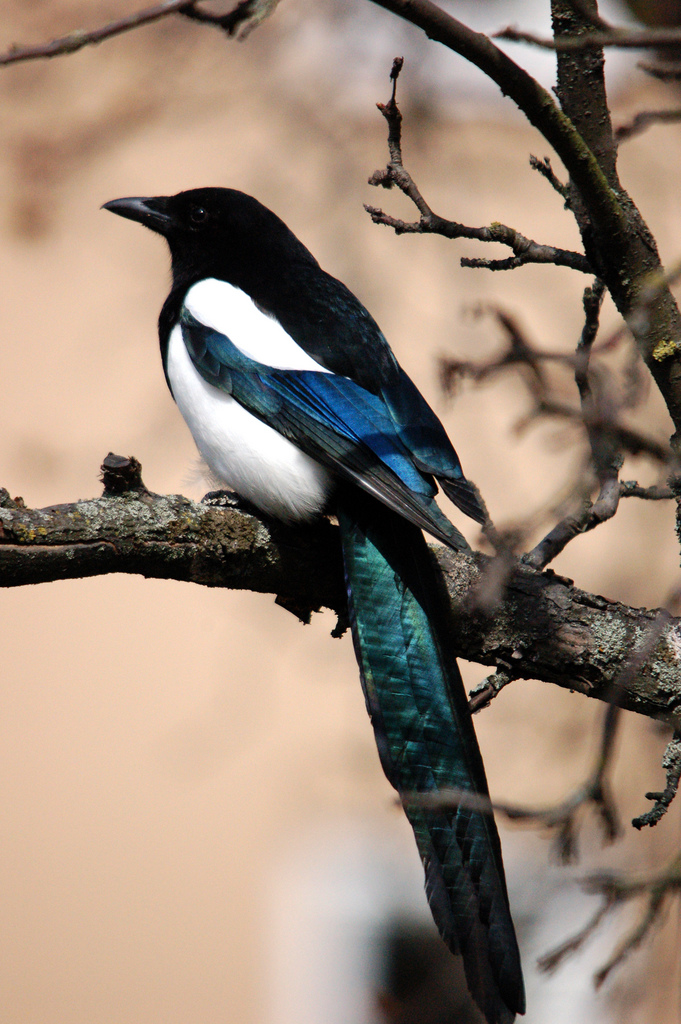| Pica | |
|---|---|
 |
|
| Eurasian Magpie (P. pica) | |
| Scientific classification | |
| Kingdom: | Animalia |
| Phylum: | Chordata |
| Class: | Aves |
| Order: | Passeriformes |
| Family: | Corvidae |
| Genus: | Pica Brisson, 1760 |
| Species | |
Pica is the genus of two to four species of birds in the family Corvidae in both the New World and the old. They have long tails and have predominantly black and white markings. One species ranges widely from Europe through Asia, one occurs all over North America and the third is restricted to California. They are usually considered closely related to the blue and green magpies of Asia, but recent research (Ericson et al., 2005) suggests their closest relatives are instead the Eurasian crows.
Two or three species were generally recognized, the Yellow-billed and one or two black-billed ones. Recent research has cast doubt on the taxonomy of the Pica magpies (Lee et al., 2003). P. hudsonia and P. nuttalli are each other's closest relatives, but may not be different species. If they are, however, at least the Korean race of P. pica would have to be considered a separate species, too.
- Eurasian Magpie, Pica pica
- Korean Magpie, Pica (pica) sericea
- Yellow-billed Magpie, Pica nuttalli
- Black-billed Magpie, Pica hudsonia
A prehistoric species of Pica, Pica mourerae, is known from fossils found in Pliocene-Pleistocene boundary strata on Mallorca.
References [link]
- Ericson, Per G. P.; Jansén, Anna-Lee; Johansson, Ulf S. & Ekman, Jan (2005): Inter-generic relationships of the crows, jays, magpies and allied groups (Aves: Corvidae) based on nucleotide sequence data. Journal of Avian Biology 36: 222-234. PDF fulltext
- Lee, Sang-im; Parr, Cynthia S.; Hwang,Youna; Mindell, David P. & Choea, Jae C. (2003): Phylogeny of magpies (genus Pica) inferred from mtDNA data. Molecular Phylogenetics and Evolution 29: 250-257. doi:10.1016/S1055-7903(03)00096-4 PDF fulltext
| Wikispecies has information related to: Pica |
| This Corvidae-related article is a stub. You can help Wikipedia by expanding it. |
https://wn.com/Pica_(genus)
Pica
Pica or PICA may refer to:
Biology
Moths
Sea snails
Organizations

Pica (disorder)
Pica (/ˈpaɪkə/ PY-kə) is characterized by an appetite for substances that are largely non-nutritive, such as paper, clay, drywall or paint, metal, chalk, soil, glass, or sand. According to DSM-IV (Diagnostic and Statistical Manual of Mental Disorders, 4th Edition) criteria, for these actions to be considered pica, they must persist for more than one month at an age where eating such objects is considered developmentally inappropriate, not part of culturally sanctioned practice and sufficiently severe to warrant clinical attention. It can lead to intoxication in children, which can result in an impairment in both physical and mental development. In addition, it can also lead to surgical emergencies due to an intestinal obstruction as well as more subtle symptoms such as nutritional deficiencies and parasitosis. Pica has been linked to other mental and emotional disorders. Stressors such as emotional trauma, maternal deprivation, family issues, parental neglect, pregnancy, and a disorganized family structure are strongly linked to pica as a form of comfort.
Pica (typography)
The pica is a typographic unit of measure corresponding to 1⁄72 of a foot, or 1⁄6 of an inch. The pica contains 12 point units of measure.
The pica originated around 1785, when François-Ambroise "L'éclat" Didot (1730–1804) refined the typographic measures system created by Pierre Simon Fournier le Jeune (1712–1768). He replaced the traditional measures of cicéro, Petit-Roman, and Gros-Text with "ten-point", "twelve-point", etc.
To date, in printing these three pica measures are used:
Note that these definitions are different from a typewriter's pica setting, which denotes a type size of ten characters per horizontal inch.
Usually, pica measurements are represented with an upper-case "P" with an upper-right-to-lower-left virgule (slash) starting in the upper right portion of the "P" and ending at the lower left of the upright portion of the "P"; essentially drawing a virgule ( / ) through a "P". (P̸) Likewise, points are represented with number of points before a lower-case "p", for example, 5p represents "5 points", and 6P̸2p represents "6 picas and 2 points", and 1P̸1 represents "13 points", which is converted to a mixed fraction of 1 pica and 1 point.

